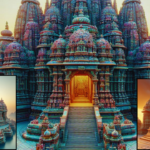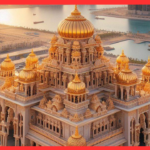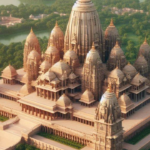Sri Kalahasti Temple
In the ancient Pandya kingdom, there was a proud poet named Nakeerudu who mistreated other poets due to his scholarship. One day, Lord Shiva, disguised as a poet, tested Nakeerudu with a poem about Mother Parvathi\’s hair. An argument ensued, and when Nakeerudu didn’t recognize Lord Shiva, he was cursed with leprosy. To seek forgiveness, he embarked on a journey from Tamilnadu to the Himalayas, specifically Kailasham. During his challenging journey, Nakeerudu prayed for help, and Kumaraswamy guided him to the Suvarnamukhi River. After a dip, he found himself in front of Sri Kalahasti temple, not Kailasham. Following darshan, Nakeerudu was miraculously cured of leprosy.
Sri Kalahasti, often overlooked, is considered Dakshina Kailasham. It holds spiritual significance, symbolized by the Suvarnamukhi river, comparable to the Ganga in the north. The 13 must-see places in Kalahasti include the Manikarnika Ghat, where bathing is equated to the Ganga, and Patala Ganapati, recognized by Agastya Maharshi.
Four important deities face different directions: Patala Ganapati (north), Lord Shiva (west), Ammavaru (east), and Dakshina Murti Swami (south). Noteworthy locations include Agastya Maharshi\’s idol, the Nandi with a hole, and Saraswati teertham, believed to aid those with speech impediments.
A visit to Sri Kalahasti temple isn’t just for Rahu Ketu puja; it\’s an opportunity to experience the divine.
Sri Kalahasti Temple Secrets
As you step inside, an intriguing sight awaits you – an unusual Nandi lying on the floor. This Nandi, known as Sharanagati Nandi, lies with its legs spread, unlike other Nandis in Shiva temples. Its significance lies in the message it conveys about false pride and surrender.
If you glance outside through a hole, spot the Maha Nandi sitting in a posture. However, Sharanagati Nandi is placed just a few feet before Lord Shiva inside the temple. The symbolism is clear: shedding false pride brings you closer to the divine. Moving forward, encounter Kalahasteeshwara Swami, the main deity of the temple. Here notice a lamp with two wicks hanging in front of the deity. This unique feature represents the Pancha Bhuta Linga aspect of Kalahasti, with the two wicks symbolizing the constant wavering of wind, signifying Vayu Lingam.
The lingam itself is distinctive, taking a square shape with a shield featuring nine steps, known as Prana Lingam or the Nava Graha Kavacham. This shield signifies the control of the planetary forces by Kalahasteeshwara Swami.
Notably, the Kalahasti temple remains open during eclipses, a rarity among Hindu temples. The temple is renowned for Rahu and Ketu pujas, owing to the significance of the Nava Graha Kavacham.
Snake, Elephant, and Spider(Sri Kalahasti Temple)
Exploring further, came across a model lingam outside the temple, showcasing the snake, elephant, and spider-like shapes on the actual lingam, which cannot be seen due to the shield.
Heading toward the Ammavaru temple will find Saneeswarudu, a powerful idol associated with the effects of Shani. Nearby, the distribution of teertham takes on special importance in Kalahasti, as it is the sanctified water used in Lord Shiva\’s Abhishekam.
Inside the Ammavaru temple, will witness the standing deity of Mother Jnana Prasunamba, a symbol of knowledge. Ammavaru, in human form, chanted the powerful Shiva Panchakshari mantra, infusing the temple with divine energy.
Don’t miss the celestial corridor, adorned with twelve zodiac signs on the ceiling. Standing underneath and praying to Ammavaru is believed to alleviate doshas in one\’s horoscope.
Venturing towards the Shikara Darshanam, will find three marks on the floor. Peering through these holes will see the Gopurams of Kalahasteeshwara Swami and Ammavaru temples, along with the hilltop Kannappa temple, symbolizing the equality of devotees.
Sri Kalahasti Temple Timings

South side of Gopuram
Lastly, as you exit through the South side of Gopuram, Dakshina Murti awaits, radiating a unique vibrancy. The priest and the idol both shine brightly and reciting Dakshina Murthy stotram here holds immense significance.
For those with the inclination, steps lead to the Kannappa temple on the hilltop, where the divine placed their devotee above themselves, showcasing the boundless mercy of the divine. Exploring the mysteries beneath the door sill of Sri Kalahasti temple’s main entrance, we uncover two hidden secrets. One is associated with the timeless sage Romasa Maharshi, who has existed for millions of years in his subtle form near the door sill. The other secret lies in the samadhi (tomb) of the devoted poet Dhurjati, a revered figure from a few hundred years ago.
Romasa Maharshi\’s story
Romasa Maharshi\’s story takes us back to a time when Lord Brahma, filled with pride, needed correction. Lord Vishnu disguised himself and led Brahma to Romasa Maharshi, a dedicated devotee of Lord Shiva. Brahma, unfamiliar with Romasa, inquired about him. Vishnu revealed that Romasa was a devoted Shiva bhakta instructed by Vishnu to perform penance for salvation. The catch was that each hair on Romasa\’s body represented the duration of one Brahma\’s lifetime. The revelation left Brahma humbled and Romasa\’s penance continued for eons.
Romasa Maharshi, having visited holy places and sanctified them, chose Sri Kalahasti as his eternal abode in subtle form under the door sill. Although some believe his presence is at the south entrance opposite Dakshina Murthy Swami, others suggest alternative locations in Chennai and beyond. These discrepancies arise because great souls like Romasa Maharshi, with the power to live eternally, manifest in human form when needed and leave their mortal bodies when their purpose is fulfilled. The samadhis are where they relinquish their mortal forms.
The second remarkable personality
Here the second remarkable personality is Dhurjati, a poet and devotee who served in the court of Sri Krishnadevaraya. His samadhi rests under the door sill, hidden beneath the metal structure. Dhurjati was known for his profound repentance and devotion to Lord Shiva, despite his acknowledged weakness for the company of courtesans. He expressed his remorse through poignant poems, and his masterpiece, Kalahasti Shatakam, reflects his deep self-reflection and plea for spiritual growth.
Dhurjati’s samadhi teaches a valuable lesson – the significance of genuine repentance and devotion. Though he may not have engaged in elaborate rituals or yogic practices, his heartfelt cries before the deity earned him a special place under the door sill.
Conclusion
These samadhis have been present for many centuries, silently teaching profound lessons. The presence of samadhis in temples to the elevated status of these great personalities in the hearts of the divine.
Understanding the cultural nuances and traditions associated with temple etiquette helps us preserve the sanctity of these sacred spaces.






